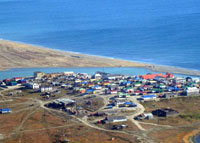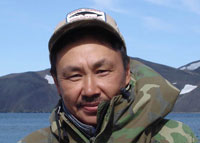 This area is situated from the north bank of the Penkigmgei Bay to the south coast of the Mechigmen Bay, including the Marich River and the Getlyanen River. This area is known for its natural and cultural heritage monuments. The famous Whale Bone Alley, stretching over 500 meters along the coast, is situated on the northern side of the Itygran Island. The site was officially documented in 1976. A long assemblage of whale jaw bones, ribs, vertebra, and numerous meat pits, the Whale Bone Alley has been the center of the spiritual life for local maritime cultures between the 14th and the 20th centuries AD. Another important site, also shaped like a bone alley is called Masik, located by the Mechigmen Bay. It is an ancient settlement, inhabited from the 13th through the 20th centuries A.D. Initially Masik was an Eskimo settlement, but closer to historic times was occupied by the maritime Chukchi people.
This area is situated from the north bank of the Penkigmgei Bay to the south coast of the Mechigmen Bay, including the Marich River and the Getlyanen River. This area is known for its natural and cultural heritage monuments. The famous Whale Bone Alley, stretching over 500 meters along the coast, is situated on the northern side of the Itygran Island. The site was officially documented in 1976. A long assemblage of whale jaw bones, ribs, vertebra, and numerous meat pits, the Whale Bone Alley has been the center of the spiritual life for local maritime cultures between the 14th and the 20th centuries AD. Another important site, also shaped like a bone alley is called Masik, located by the Mechigmen Bay. It is an ancient settlement, inhabited from the 13th through the 20th centuries A.D. Initially Masik was an Eskimo settlement, but closer to historic times was occupied by the maritime Chukchi people.
 Artur Apalu observing the Yanrakynnot area of the Beringian Park
Artur Apalu observing the Yanrakynnot area of the Beringian Park
This area of the Park surrounds the community of Yanrakynnot, ‛the lonely stand“. It is a large Chukchi community inhabited by families of reindeer herders and sea mammal hunters. Current population is around 330 people. The village has a new school, new diesel power plant, local administrative offices, and a health clinic.
The local people hunt gray and bowhead whales, harbor porpoises, walrus, ringed seals, spotted seals, and white whale. Occasionally we encounter minke whales and humpbacks. Other wildlife includes wolf, snow ship, arctic fox, fox, wolverine, and lemming. Among the birds are northern fulmar, common eider, herring gull, black-legged kittiwake, glaucous gull, gyrfalcon, and tundra swan. The nature monument Seniavinskie Hot Springs shares its name with the nearby Seniavinskii Strait. The site is visited by tourists occasionally, but for most it is too difficult to access. No roads, no vehicles!
